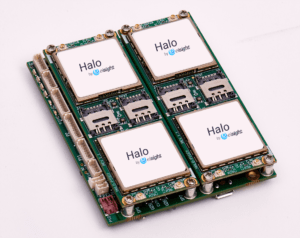


 Elsight Delivers Connection Solutions for Multi-Domain Autonomous Operations
Elsight Delivers Connection Solutions for Multi-Domain Autonomous Operations
By: Dawn Zoldi
Elsight, an Israeli-based company that provides artificial intelligence-enabled communications connectivity solutions is best known for its enablement of beyond visual line of sight (BVLOS) drone operations. Its seminal product, Halo, enables much more: one-to-many drone operations, multi-domain autonomous vehicle operations and even non-vehicle related bi-directional remote operations (think: synchronous educational classes). The company continues to refine its “connection confidence” solution and has big plans for 2022.
The Origins of Connection
Two former members of the Israeli Special Forces who had the foresight to innovate the world of video and audio transmission founded Elsight in 2009. The company initially focused on supporting reliable communications for military, homeland security and law enforcement operators. It primarily provided connectivity for video backhauling. Its first product streamed video from tactical units in the field to operations centers and headquarters.
The company rapidly expanded to the commercial sector. By 2017, Elsight had successfully integrated its proprietary “6th Sense” Artificial Intelligence into an overall communications solution set. This AI-logic core autonomously and automatically leverages the strongest IP connection signals and bonds them together to ensure connectivity and maximum available bandwidth in real-time.That same year, Elsight went public on the Australian Securities Exchange (ASX).
While Elsight’s connectivity solution continued to provide optimized networked communication connectivity for defense and public safety sectors and other markets, such as remote education, a market analysis led company leaders to focus on multi-domain unmanned autonomous systems. This led to the creation of Halo.
Yoav Amitai, the company’s CEO described the Halo product: “It leverages the best signal or connection type available, ranging from RF to LTE, to 4G, to satellite communications and then bonds multiple signals together into one connection. It switches connections autonomously and seamlessly without degradation in the required bandwidth or signal.” He continued, “Like switching an engine mid-flight, we can switch connections mid-flight.”
In 2019, Elsight made the Halo solution commercially available.
The BVLOS Solution

 With 6th Sense as the core intelligence, Halo, a baked-in or plug-and-play hardware and software solution, can easily integrate into various designs and platforms. It is modular, configurable, or standalone and backed up by a cloud.
With 6th Sense as the core intelligence, Halo, a baked-in or plug-and-play hardware and software solution, can easily integrate into various designs and platforms. It is modular, configurable, or standalone and backed up by a cloud.
Here’s how it works: Halo encapsulates the incoming traffic into an encrypted VPN tunnel, which is then broken into pieces. Each piece is sent through a different link, based on capacity and quality, to the Elsight cloud-service, together with redundancy. All the encrypted parts are received in the cloud service where they are re-puzzled, re-sequenced and de-duplicated, and the restored stream is forwarded to the Elsight VPN service. Any ground station in the world can then securely connect to the VPN service, and communicate with all connected drones.
The Halo application provides ultimate visibility, management, and control features to allow clients to prioritize signals based upon a multitude of parameters such as Signal Quality, Preferred Network Provider, Preferred Connection Type, Data Thresholds, and Cost. This allows Elsight’s clients to “educate” and personalize their AI-logic core by individual Halo, by account, by client, by solution, or by geo-location deployment, to name just a few.
Its extensive cloud management platform called Allsight Cloud Manager allows for Elsight’s clients or partners to manage the devices, connections and secure data transfer from anywhere. Clients can also use their own cloud. The system is platform agnostic on every level.
Three Key Benefits of Solid Drone Connectivity
Amitai also explained the three key benefits of utilizing Halo:
1. Reliability – In the background, transparent to the operator, Halo constantly ensures that all links are connected. If they are not, the system will restream the information to a different link autonomously. This provides critical redundancy. “The system allows pilots to focus on other important things without having to worry about one of the most critical elements: connectivity,” said Amitai. “Halo provides for robust, reliable and resilient operations with the click of a button.” This is critical for both BVLOS and one-to-many drone and other autonomous vehicle operations.
2. Bandwidth – Halo provides high quality streamed video from any platform to remote locations, because links are aggregated. Amitai explained, “If you get 5 megabits per second from each one of the cellular carriers, then combining several of these will yield 20 megabits. This makes for a more robust signal and better quality stream.” The channel is also 2-way, providing high quality information wherever needed.
3. Security – Elsight designed the system fully encrypted for high level cybersecurity. “Because we grew up in the military and defense theaters, we are very versed in onsite, federated, secure deployments within more secure and managed facilities,” noted Amitai. “Cybersecurity is not only important for government organizations, but for all remote operations.
Global Reach
In 2020, Elsight began delivering its critical network access to customers on a global scale. This was no easy feat.
According to Ben Gross, Elsight’s Director of Marketing, “We had to obtain special permission from the Israeli government to sell our technology commercially and globally because of the sensitivity that it provides end-users with such an incredible technological advantage. We had to work really hard to take off those handcuffs.”
And so they did. Now, Elsight offers the Halo solution to global clients and partners who leverage it across a broad swath of use cases. “Because we are in the BVLOS market, we provide a full suite of solutions to enable those operations, to enable all types of those operations, whether military or commercial,” said Gross.
In Israel, the company has supported more than ten thousand beyond visual line of sight (BVLOS) drone deliveries as part of the country’s National Drone Initiative called NAAMA. Co-driven by Israel’s Innovation Authority, Civil Aviation Authority, Ministry of Transport, Ayalon Highways and few others, the project aims to create a vibrant drone ecosystem through industry collaboration and regulatory development. It consists of an 8 phase program, split into quarterly 2-week long demonstrations.
“In late 2021 we participated in NAAMA Phase 3, where drone deliveries took over Tel-Aviv’s metropolitan skies, delivering ice cream, sushi, beer, blood samples and many more across a large, populated area,” lauded Gross. The Halo solution proved out to be 99.9% reliable during these demos.
Outside of Israel, the company’s main market focus is in the US. Elsight has recently partnered with DroneUp, the company working with big retail outfits on last mile drone deliveries.
In addition to the DroneUp deal, TD Synnex, an organization created from the merger of multi-billion dollar resale companies Tech Data and Synnex, recently added Halo to its solution deck. TD Synnex is one of the world’s largest technology distributors that helps companies like HP, Apple, Cisco, Microsoft and hundreds of others bring their products to market.
Elsight’s products have also made their way into European, the Middle-Eastern, Australian, Latin American and several Asian markets. Its team works with both private and government owned entities to enable their connectivity needs for drone-delivery, mapping and surveying operations. Its global partners also include global drone manufacturers and flight computer providers that integrate Halo into their products.
2021 was a big year for company growth, as the Halo system took off during the pandemic. Gross reflected, “The pandemic highlighted the need to bridge the digital divide for remote businesses to allow individuals and teams to connect to each other. Elsight took on the mission to close that gap across a range of efforts from healthcare, to education, to logistical services.”
Over the Horizon
As for what’s next for Elsight, the company will continue evolving its tech, among other things, incorporating 5G and building out the digital infrastructure needed for repeatable, safe and scalable autonomous vehicle operations.
The company also will engage in the next phase of the NAAMA demos in March 2022 and other research and development with partners globally. It also plans to have a presence at AUVSI Xponential 2022 in Orlando, Florida at the end of April.
The company continues to seek partnerships across a variety of different concepts of operations, both military and commercial.
Gross emphasized, “Elsight is excited to continue our engagement with our current clients, partners, and companies that are pulling us into broader solutions and integration discussions. Those areas include leveraging our military level secure data transfer, data assimilation, comprehensive UAV/Drone lifecycle and business operation management, global connectivity aggregation, and integrated blackbox drone solutions.”
Missed Dawn’s interview with Elsight? Stream it now: Elsight on Dawn of Drones This Week: AI-Powered Drone Connectivity Solution

 Dawn M.K. Zoldi (Colonel, USAF, Retired) is a licensed attorney with 28 years of combined active duty military and federal civil service to the Department of the Air Force. She is an intIernationally recognized expert on unmanned aircraft system law and policy, a columnist for several magazines,recipient of the Woman to Watch in UAS (Leadership) Award 2019, President and CEO of UAS Colorado and the CEO of P3 Tech Consulting LLC. For more information, visit her website at: https://www.p3techconsulting.com.
Dawn M.K. Zoldi (Colonel, USAF, Retired) is a licensed attorney with 28 years of combined active duty military and federal civil service to the Department of the Air Force. She is an intIernationally recognized expert on unmanned aircraft system law and policy, a columnist for several magazines,recipient of the Woman to Watch in UAS (Leadership) Award 2019, President and CEO of UAS Colorado and the CEO of P3 Tech Consulting LLC. For more information, visit her website at: https://www.p3techconsulting.com.
Miriam McNabb is the Editor-in-Chief of DRONELIFE and CEO of JobForDrones, a professional drone services marketplace, and a fascinated observer of the emerging drone industry and the regulatory environment for drones. Miriam has penned over 3,000 articles focused on the commercial drone space and is an international speaker and recognized figure in the industry. Miriam has a degree from the University of Chicago and over 20 years of experience in high tech sales and marketing for new technologies.
For drone industry consulting or writing, Email Miriam.
TWITTER:@spaldingbarker
Subscribe to DroneLife here.
See Also
Tags: Dawn of Dronesdrone connectivitydrone podcastselsightHalomulti domain operations





Related Posts
DJI Urges Federal Agencies to Initiate NDAA-Mandated Security Review Ahead of December Deadline
DCMA’s US-X Launches Blue List UAS Website to Speed Delivery of Trusted Drones
Ondas Secures Second $8.2M Counter-UAS Order to Protect Major European Airports